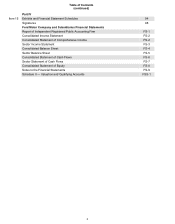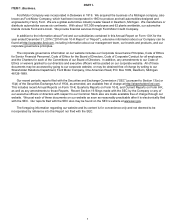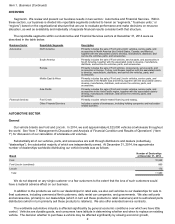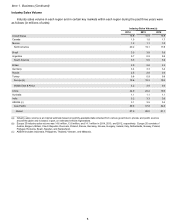Ford 2014 Annual Report Download - page 16
Download and view the complete annual report
Please find page 16 of the 2014 Ford annual report below. You can navigate through the pages in the report by either clicking on the pages listed below, or by using the keyword search tool below to find specific information within the annual report.Item 1. Business (Continued)
Other National Requirements. Many countries, in an effort to address air quality concerns, are adopting previous
versions of European or United Nations Economic Commission for Europe (“UN-ECE”) mobile source emissions
regulations. Some countries have adopted more advanced regulations based on the most recent version of European or
U.S. regulations; for example, China adopted emission regulations for large cities based on European Stage V emissions
standards. Korea and Taiwan have adopted very stringent U.S.-based standards for gasoline vehicles, and European-
based standards for diesel vehicles. Although these countries have adopted regulations based UN-ECE or U.S.
standards, there may be some unique testing provisions that require emission-control systems to be redesigned for these
markets. Canadian criteria emissions regulations are aligned with U.S. Tier 2 requirements discussed above. In
September 2014, the Canadian federal government published the proposed amendments to the On-Road Vehicle and
Engine Emission Regulations and the Sulphur in Gasoline Regulations. The final regulations are expected to align
standards with the U.S. Tier 3 regulations.
Furthermore, not all countries have adopted appropriate fuel quality standards to accompany the stringent emissions
standards adopted. This could lead to compliance problems, particularly if on-board diagnostic or in-use surveillance
requirements are implemented. Japan has unique standards and test procedures, which may require that unique
emissions control systems be designed for the Japanese market.
Brazil, Argentina, and Chile have also introduced more stringent emissions standards. Since 2012, Brazil has applied
European Stage V emissions and on-board diagnostic standards for heavy trucks, and more stringent light vehicle
limits. Argentina also will apply light vehicle Stage V standards beginning in 2015 (for new vehicle homologations) and
2017 (for new vehicle registrations). Chile introduced more stringent emission standards (i.e., European Stage V or
corresponding U.S. emissions standards) nationwide for light and medium duty vehicles in September 2014. Since
October 2014, new heavy duty vehicle models are required to meet Stage V (or corresponding U.S. emissions standards).
All other new heavy vehicles are required to meet these standards beginning October 2015.
Vehicle Fuel Economy and Greenhouse Gas Standards
U.S. Requirements - Light Duty Vehicles. Federal law requires that light duty vehicles meet minimum corporate
average fuel economy (“CAFE”) standards set by the National Highway Traffic Safety Administration (“NHTSA”). A
manufacturer is subject to substantial civil penalties if it fails to meet the CAFE standard in any model year, after taking
into account all available credits for the preceding three model years and expected credits for the five succeeding model
years. The law requires NHTSA to promulgate and enforce separate CAFE standards applicable to each manufacturer’s
fleet of domestic passenger cars, imported passenger cars, and light trucks, respectively.
The EPA also regulates vehicle greenhouse gas emissions under the Clean Air Act. Because the vast majority of
greenhouse gases emitted by a vehicle are the result of fuel combustion, greenhouse gas emission standards effectively
are fuel economy standards. Thus, it is necessary for NHTSA and EPA to coordinate with each other on their fuel
economy and greenhouse gas (“GHG”) standards, respectively, to avoid potential inconsistencies.
In 2010, EPA and NHTSA jointly promulgated regulations establishing the “One National Program” of CAFE and GHG
regulations for light duty vehicles for the 2012-2016 model years. In 2012, EPA and NHTSA jointly promulgated
regulations extending the One National Program framework through the 2025 model year. These rules require
manufacturers to achieve, across the industry, a light duty fleet average fuel economy of approximately 35.5 mpg by the
2016 model year, 45 mpg by the 2021 model year, and 54.5 mpg by the 2025 model year. Each manufacturer’s specific
task depends on the mix of vehicles it sells. The rules include the opportunity for manufacturers to earn credits for
technologies that achieve real-world CO2 reductions, and fuel economy improvements that are not captured by EPA fuel
economy test procedures. Manufacturers also can earn credits for GHG reductions not specifically tied to fuel economy,
such as improvements in air conditioning systems.
The One National Program standards become increasingly stringent over time, and they will be difficult to meet if fuel
prices remain relatively low and market conditions do not drive consumers to purchase electric vehicles and other highly
fuel-efficient vehicles in large numbers. The rules provide for a midterm evaluation process under which, by 2018, EPA
and NHTSA will re-evaluate their standards for model years 2022-2025 in order to ensure that those standards are
feasible and optimal in light of intervening events. We are particularly concerned about the commercial feasibility of
meeting the 2022-2025 model year GHG and CAFE standards, and therefore the midterm evaluation process is very
important to Ford and the auto industry. Ford’s ability to comply with the 2022-2025 model year standards remains
unclear because of the many unknowns regarding technology development, market conditions, and other factors so far
into the future. We intend to be an active participant in the midterm evaluation process for these standards. Our concern
about the feasibility of the fuel economy / GHG standards also extends to some of the pre-2022 model year standards,
which are not covered by the midterm evaluation.
10
























